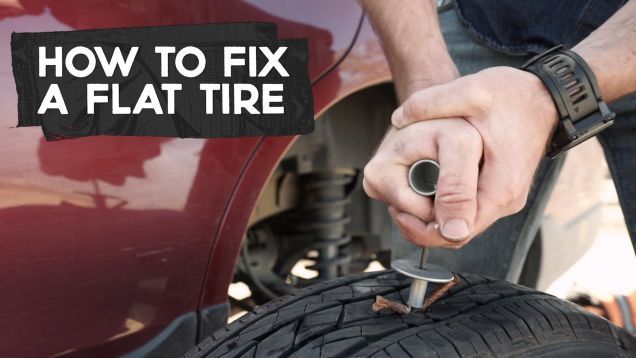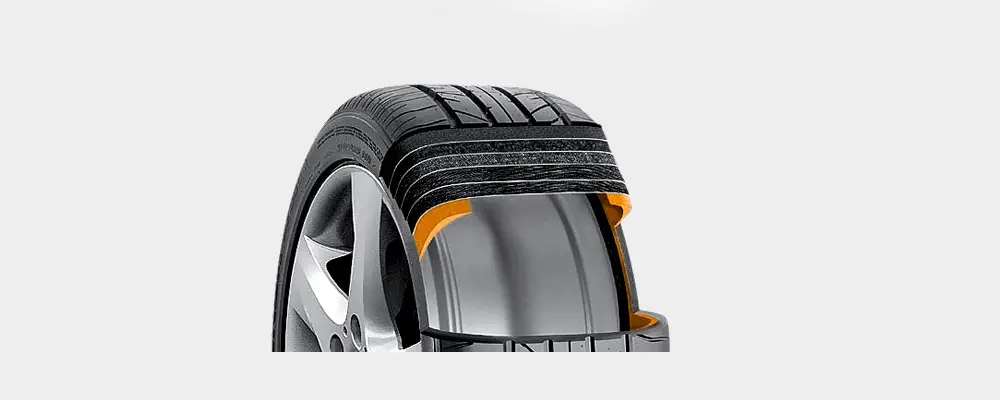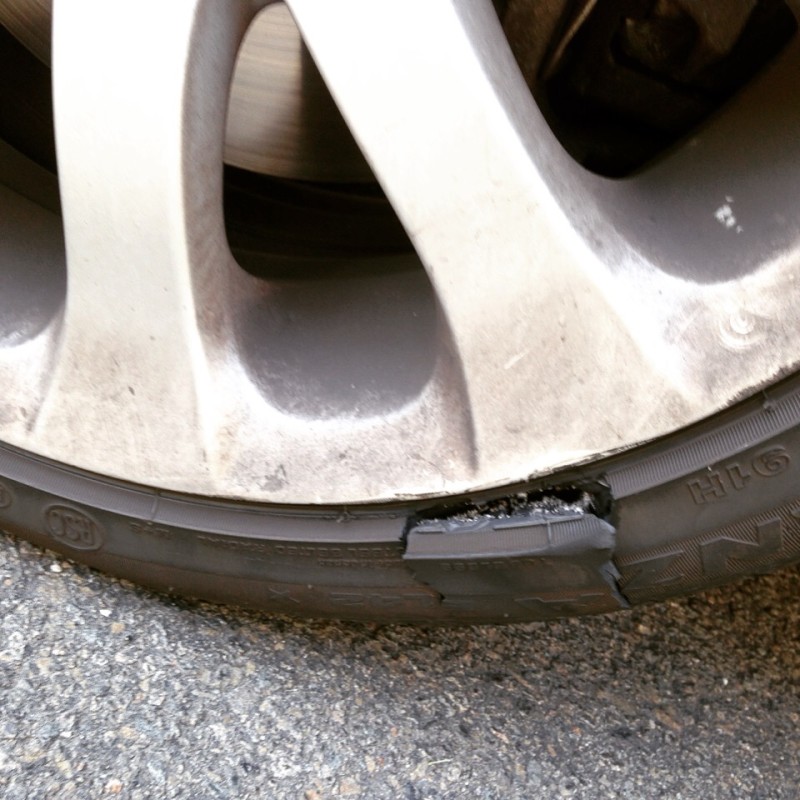Though they first appeared in the mid-1980s, run flat tires (RFT) are now more popular than ever. With some auto manufacturers making them standard in new vehicles, more consumers are asking about run flats, their advantages, and how using them impacts driving.
Run flat tires are tires on which you can continue driving after a puncture so you can take time get to an auto shop or find a safe, level area to change your tire.
You can’t drive on them indefinitely, though. Check the manufacturer’s specifications to find out how fast and how far you can drive on your run flat tires. Bridgestone run-flat tires will allow continued operation even after a loss of some or all inflation pressure for up to 50 miles (80 km) at a maximum speed up to 50 mph (80 km/h.)
There are two primary types of run flat tire systems: the self-supporting system and the support ring system.
In most self-supporting run flat tire systems, the tire features reinforced sidewall construction that will continue supporting the vehicle in the event of air loss. This construction allows continued operation after the loss of air pressure up to the speed and distance specified by the manufacturer.
Support ring run flat tire systems, on the other hand, employ a ring of hard rubber or another structure that can support the vehicle’s weight in an air loss condition.
Since they continue performing even though they’re “flat,” all run flat tires, regardless of the specific system type, may only be used on a vehicle equipped with a Tire Pressure Monitoring System (TPMS). The TPMS alerts you as soon as one of your tires loses pressure. Without it, you might not know you were driving on an underinflated tire.
You don’t have to change your tire in dangerous or uncomfortable conditions. This is perhaps the biggest benefit of run flat tires and is the one of the reasons why they were designed. With conventional tires, you have to replace a flat on the spot or have your car towed.
With conventional tires, you have to replace a flat on the spot or have your car towed.
In a puncture situation, run flats are more stable than conventional tires. Since they’re made to support your vehicle even when they contain no air, run flat tires will help you maintain better control in a complete air loss situation than conventional tires.
As consumers continue rating safety high on the list of features they look for in a vehicle, the popularity of run flat tires is expected to grow. Since run flat tires work reliably with interconnected technologies like TPMS, it may only be a matter of time before they become the norm rather than the exception in new vehicles.
There’s never a good time for a flat. That’s why Bridgestone DriveGuard tires are masterfully engineered to keep you moving for up to 50 miles at speeds up to 50 MPH without disruption.
See Details Find Your Fit
There’s never a good time for a flat. That’s why Bridgestone DriveGuard tires are masterfully engineered to keep you moving for up to 50 miles at speeds up to 50 MPH without disruption.
That’s why Bridgestone DriveGuard tires are masterfully engineered to keep you moving for up to 50 miles at speeds up to 50 MPH without disruption.
The world of tires is an ever-expanding nexus of increasingly specialized compounds for any situation. There are tires for everyday roads, snow, rain, summer, racing, off-roading and tires that attempt to handle multiple terrains.
A smaller slice of the tire market is the run flat tire, which usually appears on luxury or heavy vehicles. Basically run flat tires have a contingency built in that allows a driver to continue on the road if it experiences a puncture, allowing them to get somewhere safely for a replacement.
But what exactly is a run flat tire, how do they work and how do you know if you need one? Here's a rundown.
The Bridgestone DriveGuard Plus is an auxiliary-supported run flat tire. BridgestoneWhat sets a run flat tire apart from the average road tire is its ability to travel certain distances after receiving a puncture and losing air. This allows you to safely find the nearest auto shop or tire seller for a replacement. Typically they can go about 50 miles at about 50 mph.
This allows you to safely find the nearest auto shop or tire seller for a replacement. Typically they can go about 50 miles at about 50 mph.
The first run flat tires sprouted up in 1935, when Michelin adapted technology used for trains to make a road tire that would run on a safety rim on built-in foam lining when the tire was punctured.
In the 1950's, Chrysler and Goodyear collaborated on the Captive Air run flat tire, which was advertised as having an inner emergency tire that could travel for more than 100 miles if the outer wall was punctured.
Every major tire manufacturer operating today makes run flat tires.
The Bridgestone DriveGuard Plus comes in most common sizes. BridgestoneThere are three main technologies used in run flat tires: self-supporting, auxiliary-supported and self-sealing.
The most common choice is the self-supporting run flat. This type of run flat features a reinforced sidewall construction, which has an increased chance of supporting the car in the event of air pressure loss. The sidewall maintains its connection to the rim.
The sidewall maintains its connection to the rim.
Popular options in this category include the Bridgestone RFT, Goodyear EMT, Michelin ZP, Yokohama Run-Flat and Pirelli RFT.
Auxiliary-supported run flats contain a ring of rubber or a similar material on the interior of the tire, which picks up the slack of the deflated outer tire. This type of run flat is usually found in heavier segments, like military or armored vehicles.
These include Pirelli Scorpion Zero Run Flats, Goodyear Eagle Sport tires, Bridgestone DriveGuard and Michelin Pilot Sport all-seasons.
Bridgestone recently announced the DriveGuard Plus, billed as an improvement on its existing line of run flats.
The company says that the tire, when new, is 12 percent more likely to resist hydroplaning than its DriveGuard counterpart. As the tire wears, it only slips to 8 percent.
Self-sealing run flats come with an extra lining just beneath the tread containing a puncture sealant. That sealant deploys automatically if the tire gets a puncture, usually fixing a hole up to 3/16ths in diameter.
Continental ContiSeal, Pirelli's Seal Inside and Michelin's Selfseal are prominent examples.
The Bridgestone DriveGuard Plus can go 50 miles after a puncture. BridgestoneIn an ideal scenario, a self-supporting run flat tire would be able to continue driving and support the weight of a vehicle due to the reinforced sidewall.
For an auxiliary-supported run flat, the weight of the flat tire rests on the backup's treads. According to tirerack.com, that shifts the mechanical responsibility of driving on a run flat to the more-sturdy wheel, lifting some of the burden off of the tire itself.
If a self-sealing tire gets a puncture, it depends on if the object sticks to the tire or not. If it remains, the compound forms around the obstruction and seals it off from the rest of the tire. If it doesn't stick, the sealant forms around the hole.
How soon after a puncture do you have to change a run flat tire?
Every tire manufacturer recommends that when arun flat system is being used, you should use the limited distance it affords you to reach a mechanic or tire shop for an immediate replacement.
Keep in mind that while 50 miles and 50 mph is the recommended distance and speed of a run flat tire, it's ideal to keep speeds lower and the distance you have to drive shorter to have a better chance of not having a full blowout.
BridgestoneSince self-supported run flats have a reinforced sidewall, it can remain stiff despite the natural loss of air pressure over time. Keep a tire pressure gauge handy and check each tire regularly.
If functioning properly (and if you don't feel the sudden loss of pressure), you should be alerted to the problem by a gauge cluster alert from the tire pressure monitoring system.
What cars come with run flats?
Many models sold from Mercedes-Benz, Infiniti, Lexus, BMW, Mini and some Cadillac models come with run flat tires. And manufacturers say that run flat tires are useful on sedans, trucks and SUVs alike, such as the 2022 BMW 3 Series, the 2022 Kia Telluride and 2022 Ford F-150.
The 2020 Ford Explorer became the first vehicle to feature Michelin's Selfseal run flat.
There are several pros and cons to weigh when considering switching to run flats.
On the upside, getting that extra mileage in the event of a puncture could save you some extra hassle in calling a tow truck or changing the tire yourself. It also frees up any space that may have been taken up by a spare tire.
The immediate presence of a backup system also means that the car will be easier to drive, even if it's deflating.
On the other hand, run flat tires are usually more expensive than other tires. For example, a set of four Pirelli P Zero Run Flat tires for a 2022 BMW 3 Series can cost $1,270.40, according to TireRack. A set of non-run flats for the same car, like four Michelin Primacy Tour all-seasons, run for $960. They also represent a small slice of the overall tire market, so supplies may be limited, especially with ongoing supply chain issues affecting every facet of the automotive industry.
Additionally, many cars that come standard with run flat tires don't include a spare. And with a stiffer sidewall, run flat tires ride noticeably more harshly than standard tires. Each buyer will have to weigh the pros and cons, and decide if the premium is worth the payoff.
1 What is RunFlat?
RunFlat is translated into Russian as “flat driving” or driving on a flat tire. Tire manufacturers use different technology designations (example: Goodyear RunOnFlat, Bridgestone RFT, Michelin ZP, Continental SSR, Pirelli Run Flat, Dunlop RunOnFlat, Nokian Flat Run, Yokohama ZPS, Kumho XRP).
2 What are RSC tires?
RunFlat System Component is a single designation for all RunFlat tires installed on BMW vehicles.
3 What is the difference between Run Flat tires and regular tires?
4 How RunFlat Tires Work?
RunFlat technology is based on the concept of reinforced tire sidewalls. When a conventional tire deflates, it simply sags under the weight of the car, the beads move away from the rim and the sidewalls flatten onto the road. The weight completely destroys the tire in a few kilometers. Reinforced sidewalls of RunFlat tires keep the tire on the rim and successfully support the weight of the car after a puncture and complete loss of pressure. At the same time, all dynamic vehicle security systems such as ABS, ESP, DSC, CBC, etc. remain active.
When a conventional tire deflates, it simply sags under the weight of the car, the beads move away from the rim and the sidewalls flatten onto the road. The weight completely destroys the tire in a few kilometers. Reinforced sidewalls of RunFlat tires keep the tire on the rim and successfully support the weight of the car after a puncture and complete loss of pressure. At the same time, all dynamic vehicle security systems such as ABS, ESP, DSC, CBC, etc. remain active.
5 How many kilometers and at what speed can you drive after a puncture?
The maximum run-flat distance depends on the tire manufacturer and operating conditions (50-150 km) The maximum vehicle speed is 80 km/h.
6 What are the differences in RunFlat technology between tire manufacturers?
7 Are there conditions for the use of Run Flat tires?
Without a tire pressure monitoring system installed, the operation of RunFlat tires becomes extremely dangerous, because the driver may not feel the loss of pressure in the tire and continue to move without speed limits, making sharp turns and maneuvers.
8 Are special rims required for RunFlat tires?
All tire manufacturers with runflat technology allow them to be installed on standard rims.
9 Can RunFlat tires be repaired after a puncture?
Depends on the tire manufacturer (in any case, only the tread part of the tire can be repaired).
10 Benefits of RunFlat Tires
11 Disadvantages of RunFlat Tires

Category: Technical information
Article reading time: 3 minutes
Bookmark this
RunFlat car tires save the car, driver and passengers from a tire puncture at full speed. RunFlat can be driven even with zero tire pressure at speeds up to 80 km/h. With these tires, you don't need a spare. But RunFlat is an expensive technology. Such wheels are expensive and lead to excessive fuel consumption. Therefore, before buying such tires, you must weigh all the pros and cons of this technology.
Until 2007, in the design of such products of the tire industry, there was a supporting ring that was placed on the rim. After a conventional tire was punctured, the wheel did not rest on a rubber cushion, but on an elastomer ring. The car lost control and speed. In addition, the features of the technology of the first tire with puncture protection involved the transition to special wheels and the difficult replacement of seasonal rubber.
The car lost control and speed. In addition, the features of the technology of the first tire with puncture protection involved the transition to special wheels and the difficult replacement of seasonal rubber.
In 2007, tire manufacturers offered consumers a new concept - a model with a reinforced sidewall. The elastomer inner ring replaced the rigid sidewalls that the car rested on after a tire puncture. This technology has eliminated the difficulty of changing tires, as well as special requirements for the design of the rim. The new RunFlat made it possible to reach the tire shop even at a speed of 80 km/h.
The latest developments of tire manufacturers are connected with a new variety of RunFlat. A layer of polyamide is applied to the inside of the compound - a sealant that hardens upon contact with air. A rubber puncture activates the polyamide, which seals a hole up to 5 millimeters in diameter. Otherwise, they do not differ from conventional models.
Goodyearshop's online aggregator offers the latest RunFlat tires. In the catalog you will find rubber for disks of any diameter with the width and tread height you need.
The list of advantages of such a tire can be written:

The RunFlat tire should be credited with improved steering responses and savings in trunk space. But besides the pros, Run-Flat also has its cons.
Summer Drive Protection Run On Flat Sound Comfort
Rating:
4.5
Tires Goodyear Eagle F1 Asymmetric 3
Summer Drive Protection Run On Flat
Rating:
4.5
Tires Goodyear EfficientGrip Performance
Summer Drive Protection Run On Flat
Rating:
4
Tires Goodyear Wrangler HP All Weather
Summer Drive Protection Run On Flat Sound Comfort
Rating:
4. 5
5
Tires Goodyear Eagle F1 Asymmetric 2
Summer Drive Protection Run On Flat
Tires Goodyear Eagle F1 Asymmetric Suv 4x4
Summer Drive Protection Run On Flat
Tires Goodyear Eagls2
Summer Drive Protection Run On Flat
Rating:
3.5
Tires Goodyear Excellence
Winter Drive Protection Run On Flat
Rating:
4
Tires Goodyear UltraGrip Performance 2
Among the disadvantages of such tires, first of all, they note the cost - 20-30% higher than the price of the standard model. In addition, any emergency models have the following disadvantages:
In addition, any emergency models have the following disadvantages:
These disadvantages force drivers to use the classic spare tire. After all, the need for a puncture-proof wheel does not always arise.
The main consumers of such tires are special services, ambulance stations, rescuers and those who do not have time to replace a punctured tire on a flight. Close interest in such models is demonstrated by the owners of armored vehicles.